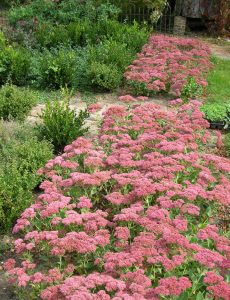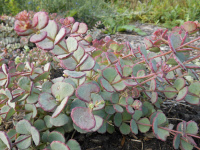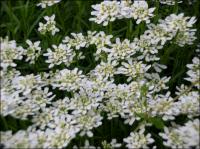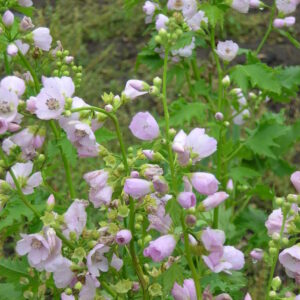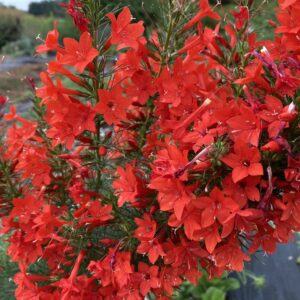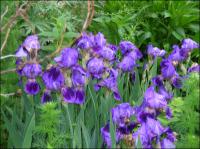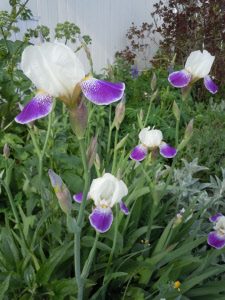Perennials & Biennials
Showing 249–256 of 485 results
-
Hylotelephium herbstsfreude syn Sedum ‘Autumn Joy’ Z 4-9
Classic, large flat flower heads turn from green to rose
Classic, large flat flower heads turn from green to rose blooming in September and October. A staple for autumn in the garden.
Size: 30” x 12”
Care: full sun in well-drained soil
Wildlife Value: Attracts many bees and butterflies. Black walnut tolerant, deer resistant.
Awards: England’s Royal Horticultural Society Award of Garden Merit.Autumn Joy introduced to gardens before 1920 by the George Arends Nursery in Ronsdorf, Germany.
-
Hylotelephium sieboldii syn Sedum sieboldii, October Daphne Z 3-9
Fleshy gray-green foliage edged with pink encircles the prostrate stems, flowering strawberry pink in fall. Perfect for rock gardens, front of border, fairy gardens, roof gardens, troughs and groundcover or anyplace with drought.
Fleshy gray-green foliage edged with pink encircles the prostrate stems, flowering strawberry pink in fall. Perfect for rock gardens, front of border, fairy gardens, roof gardens, troughs and groundcover or anyplace with drought.
Size: 4" x 8"
Care: full sun in moderately fertile, well-drained soil.
Native: Japan
Wildlife Value: Drought tolerant and deer resistant.
Awards: Elisabeth Carey Miller Botanical Garden Great Plant PickSedum means “plant that sits.” “Live forever” is an ancient Greek name for sedums. The Roman Pliny claimed that sedum’s juice treated wounds. In the 1500’s English herbalist Gerard called sedums “very full of life,” referring to succulent’s quality of being very easy to grow. This species named for its discoverer, Dr. Philipp Franz von Siebold (1791-1866). Von Siebold, a German doctor, worked for the Dutch East India Company as its resident physician on Deshima Island, off the coast of Japan. He boldly became too knowledgeable about Japanese affairs and was imprisoned by the Japanese in 1826 and then banished in 1828. When he left he carried nearly 500 plants with him to Europe. William Robinson, father of the mixed perennial border, described Sedum sieboldii as beautiful. He advised gardeners to grow it “in strong loam and mortar rubble in fully exposed positions (and use it as) an excellent plant for vases in summer.”
-
Iberis sempervirens Candytuft Z 5-9
Profuse clusters of small, pure white flowers, each flower made of multiple small petals blooming in April and May on this evergreen subshrub.
Profuse clusters of small, pure white flowers, each flower made of multiple small petals blooming in April and May on this evergreen subshrub.
Size: 6-12” x 24”
Care: Sun in moist well-drained soil
Native: Southern Europe
Wildlife Value: nectar source for gray hairstreak butterfly
Awards: England's Royal Horticultural Society Award of Garden Merit.Iberis is Latin for Spain, “Iberia” the country where the plant was first discovered. The common name “Candytuft” comes from Candia, Crete where the plant grew. In 1623 English herbalist, John Parkinson (1567-1650) included the Candytuft in his Garden of Pleasant Flowers saying it: “is not so sharpe biting in taste…and therefore is not to be used in medicines.”
-
Iliamna remota Kankakee mallow Z 4-7
Cup-shaped, 5 petaled, shell pink flowers along the 4-6’ tall stems, blooming much of the summer.
Cup-shaped, 5 petaled, shell pink flowers along the 4-6’ tall stems, blooming much of the summer.
Size: 4-5' x 18"
Care: sun to part shade in moist to moist well-drained soil
Native: Endemic to Langham Island in Kankakee River, Illinois.Collected by Rev. E.J. Hill, minister and teacher, on June 29, 1872. Botanist Edward Lee Greene (1843-1915) described and named it. In Leaflets of Botanical Observation and Criticism Greene wrote that he collected this on Langham Island in August 1, 1899 after Rev. E.J. Hill “brought this plant to knowledge.” Vol 1, 1905 pp. 206-207. http://www.botanicus.org/page/396332. Later, invasive plants threatened this plant with extinction by crowding it. After years of work the Friends of Langham Island rescued this special plant.
-
Ipomopsis aggregata Standing cypress, Skyrocket, Scarlet gilia Z 4-11 Reseeding biennial
Many attention-grabbing, cardinal red trumpets on a leafless spike in summer-fall gardens
Many attention-grabbing, cardinal red trumpets on a leafless spike in summer-fall gardens
Size: 3-5’ x 12”
Care: sun to part shade in moist well-drained to well-drained soil
Native: west from ND, south to TX to the Pacific Ocean, also western Canada
Wildlife Value: attracts bees, Swallowtail butterflies and flocks of hummingbirds. Deer resistant.Hopi made it into decorations and dye. Klamath children sucked its nectar from the flowers. Navajo remedied many ailments with this – spider bites. stomach ailments by induce purging. And they grew it for its beauty. Canada’s Salish washed their face, hair, and eyes with this. Shoshone remedied pains of rheumatism by crushing the plants and applying it to the aches. Also a remedy sexually transmitted diseases, itches, tonic for blood and induce vomiting,
Collected by Meriwether Lewis on the Lolo Trail crossing the Bitterroot Range of the Rockies, June 26 1806. Named and described initially by Frederick Pursh in Flora Americae Septronalis Vol1 p. 147 (1813) from the plant collected by Lewis on the Lewis and Clark Expedition. -
Iris ‘Monsignor’ syn. Anne’s Iris Z 3-9
Classic purple iris with sunny throat and white stripes on the beard, blossoms in late May to early June
Classic purple iris with sunny throat and white stripes on the beard, blossoms in late May to early June
Size: 15" x 8"
Care: moist well-drained soil in sun to part shadeThis Iris was growing in the gardens when we moved here in 1992. The property has been owned continuously by the Utter – Patterson family from 1880 until 1992. Anne Patterson began gardening here in 1927 as a young bride, so I call these “Anne’s Iris.” In June 2003 Anne turned 104 years old. She passed away on August 1. Hybridized at French nursery Vilmorin-Andrieux et Cie, a legendary seed house started in late 1700’s. Some firm members specialized in Irises from the 1880’s. The firm introduced ‘Monsignor’ in 1907, one of its earlier hybrids.
-
Iris ‘Spark’ Z 4-8
Early blooming, intermediate bearded iris of brick-red standards and burgundy falls with a bright spark of a beard in the middle.
Early blooming, intermediate bearded iris of brick-red standards and burgundy falls with a bright spark of a beard in the middle.
Size: 23” x 12”
Care: sun in moist well-drained soil.
Wildlife Value: Welcomes bees with easy access to pollen.Iris is named after the Greek goddess who accompanied the souls of women to the Elysian Fields by way of the rainbow. Her footprints left flowers the colors of the rainbow. Iris means the eye of heaven. The iris is the flower of chivalry, having “a sword for its leaf and a lily for its heart.” Ruskin. Spark hybridized and introduced by Col. J. C. Nicholls in 1931,
-
Iris ‘Wabash’ Z 3-8
Pure white standards with deep purple falls edged in white and a bright yellow beard in late May-early June. “A new iris so far in advance of others of similar color combination that they are simply not in the race.” Cooley’s Gardens catalog, 1938
Pure white standards with deep purple falls edged in white and a bright yellow beard in late May-early June. “A new iris so far in advance of others of similar color combination that they are simply not in the race.” Cooley’s Gardens catalog, 1938
Size: 39" x 8"
Care: sun in moist well-drained soil. In July-August lift & divide every 2 to 3 years; discard mushy rhizomes.
Wildlife Value: Deer and rabbit resistant.
Awards: Dykes award (best iris in world) winner 1940.Iris is named after the Greek goddess who accompanied the souls of women to the Elysian Fields by way of the rainbow. Her footprints left flowers the colors of the rainbow. Iris means the eye of heaven. The iris is the flower of chivalry, having “a sword for its leaf and a lily for its heart.
Hybridized by Mary Williamson in 1936, daughter of famed iris hybridizer E.B. Williamson. She became a renowned hybridizer in her own right. ‘Wabash’, is a cross of ‘Dorothy Dietz’ with ‘Cantabile.’

